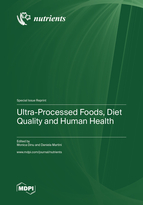Ultra-Processed Foods, Diet Quality and Human Health
A special issue of Nutrients (ISSN 2072-6643). This special issue belongs to the section "Nutrition and Public Health".
Deadline for manuscript submissions: closed (16 February 2023) | Viewed by 79255
Special Issue Editors
Interests: nutrition; diets; umbrella review; cardiometabolic factors
Special Issues, Collections and Topics in MDPI journals
Interests: nutrition; diets; sustainability; food labelling; food quality
Special Issues, Collections and Topics in MDPI journals
Special Issue Information
Dear Colleagues,
The increase in the volume of industrially processed products in the global food supply has coincided with an increasing prevalence of obesity and non-communicable diseases in many countries, suggesting that ultra-processed foods consumption may be detrimental for human health. However, studies are still limited and underline the need to better understand the main determinants of their consumption and the mechanisms that may explain the associations between these products and human health. This Special Issue aims to collect new studies investigating the relationship between the consumption of ultra-processed foods, diet quality and human health, including those aimed to:
- Develop new tools to better determine the rate of consumption of ultra-processed foods in the population
- Investigate the rate of consumption of ultra-processed foods in different subgroups of the population, including subjects following different dietary patterns
- Analyse the relationship between the consumption of ultra-processed foods and markers of health status
- Explore possible mechanisms behind associations between the consumption of processed foods and health
By providing up-to-date assessments of ultra-processed foods consumption and health implications, these reports will contribute to understand if future public health nutrition policies are needed.
Dr. Monica Dinu
Dr. Daniela Martini
Guest Editors
Manuscript Submission Information
Manuscripts should be submitted online at www.mdpi.com by registering and logging in to this website. Once you are registered, click here to go to the submission form. Manuscripts can be submitted until the deadline. All submissions that pass pre-check are peer-reviewed. Accepted papers will be published continuously in the journal (as soon as accepted) and will be listed together on the special issue website. Research articles, review articles as well as short communications are invited. For planned papers, a title and short abstract (about 100 words) can be sent to the Editorial Office for announcement on this website.
Submitted manuscripts should not have been published previously, nor be under consideration for publication elsewhere (except conference proceedings papers). All manuscripts are thoroughly refereed through a single-blind peer-review process. A guide for authors and other relevant information for submission of manuscripts is available on the Instructions for Authors page. Nutrients is an international peer-reviewed open access semimonthly journal published by MDPI.
Please visit the Instructions for Authors page before submitting a manuscript. The Article Processing Charge (APC) for publication in this open access journal is 2900 CHF (Swiss Francs). Submitted papers should be well formatted and use good English. Authors may use MDPI's English editing service prior to publication or during author revisions.
Keywords
- ultra-processed food
- weight
- obesity
- body composition
- risk factors
- non-communicable diseases
- health
- dietary patterns








